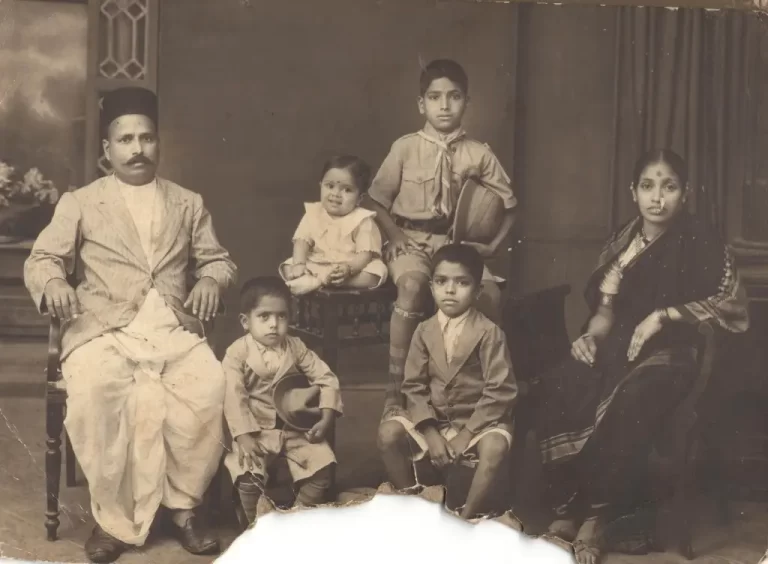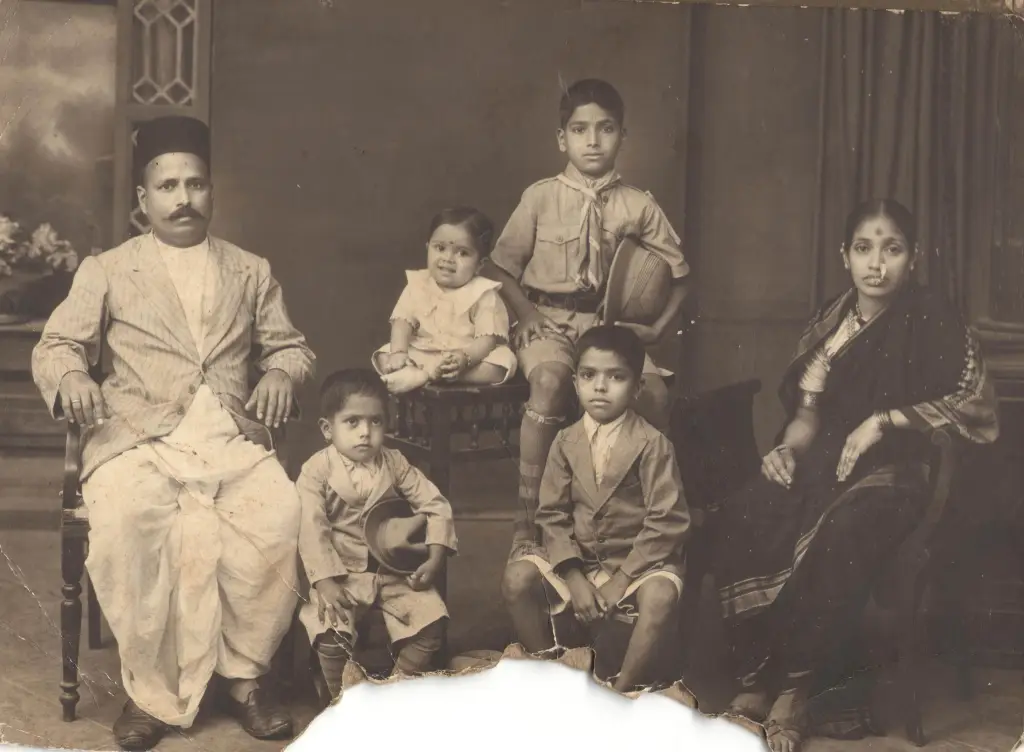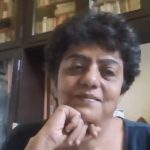
I remember seeing people in the lane in front of our house after Partition. It was a slum area next to the sweeper’s colony, and lined with the huts of poor people. The people who were taking their belongings and leaving the newly-formed Pakistan had tears in their eyes. They were saying, “Yeh kaisa azaadi mila hai, jo humko alag kiya?”
By Saaz Aggarwal
The Karachi of my childhood was a very clean and beautiful city. There may have been riots in every other city in India in those days, but not Karachi. In 1945, even Bombay had riots. One of my uncles who worked in the Port Trust at the time had to travel through a Muslim quarter and took the precaution of travelling in a cab. The cab was stopped and he sustained an injury on the back of his shoulder. But Karachi remained peaceful. It was after we left, when Karachi became populated with refugees from UP, Bihar and Punjab that the trouble began.
The transfer of population was a tragic mistake. That was what led to all the riots and killing and separation of families. These terrible things happened in peaceful places. If the two countries had been created without displacing people, they may never have happened. But the politicians were in a hurry to get power for themselves and it was the people of India and Pakistan who suffered.
One of my childhood memories is of the Independence Day function at my school. On the afternoon of 14 August, there was a big celebration and a flag hoisting ceremony. Our Principal – I think his name was Inayat Kazi, but it was so long ago that I may be mistaken – was a Muslim. However, most of the students and almost the entire teaching staff were Hindus. The Principal sensed our unease. Pakistan had been born and we did not know what our fate would be. Everything was ready for the Pakistani flag to be hoisted. He said, “Wait.” So we waited, anxious to see what he was going to do. He arranged for an Indian flag to also be brought, and he hoisted both flags, next to each other. The entire environment changed. Everybody was happy, and it became a genuine celebration.
I was a student of the NJ Vaidya High School in Karachi. It was established in 1879 by a gentleman named Narayan Jagannath Vaidya. When he died, the school was taken over by the government. A descendant of NJ Vaidya made an arrangement with the government, paying to have the name of his ancestor retained by the school. Our primary school had three separate sections: Sindhi, Gujarati and Marathi. We were taught English, but our medium of instruction was our native language. From the fourth standard onwards, the classes were combined, with English as the medium of instruction. I feel very proud when I remember the diversity in our school. My family is from Malvan, on the Konkan coast. At home we spoke our own language, Malvani Konkani, which is a dialect of Konkani with a significant Marathi influence. I could understand Sindhi, and still remember a few sentences. I excelled at Gujarati and even today I can read a Gujarati newspaper. Our school had Hindus, Muslims, Marathi-speaking Muslims, Jews and Christians. The Parsi community of Karachi was large, and many families lived in the Mama Home area. Parsi children studied at Grammar School. The Sikhs, too, had their own school.
Karachi had many temples. I remember the Shankar Mahadev temple at Native Jetty and the Panchamukhi Hanuman temple near the zoo. However, as children we also visited mosques, churches and synagogues. There was a feeling of togetherness and no hatred towards any community. In the US, where my son Nitin lives, I recently met a plumber whom I heard speaking in Gujarati. I greeted him in Gujarati and he told me that he was a Bohra from Pakistan. It was an immediate bond when I told him I had lived in Karachi as a child. His family lived in the Bohra Colony which, he told me, was very close to my old school. He also told me that some of the names have been retained. Poona Bhai Tower, a clock tower which I remember, is still called what it was when I lived there.
Karachi had a beautiful Gandhi Garden, in which there was a zoo. On the hillock you could see a monument. My father used to point it out and tell us that this was a memorial to the Maratha hero, Chimaji Appa. After Shivaji, the chief ministers and administrators of his state, the Peshwas, controlled the Maratha army and were responsible for protecting and expanding the empire. Chimaji Appa was the younger brother of Bajirao Peshwa and best known for his capture of Vasai fort from the Portuguese. I do not know if this memorial still stands in Karachi.

My father used to tell us that in the Indian uprising against the British in 1857, many of our princes – the last Moghuls, the Rani of Jhansi, some of the UP nawabs, Maratha peshwas and others – had been involved in the rebellion against the British. When the British resumed control, they had driven these people out from their homes. People were scattered. Some of our people settled in Quetta, some in Peshawar. I have been told that my grandfather was an employee of the North Western Railway. After the massive earthquake of 1935 in Quetta, he moved to Karachi.
There was a large Marathi community in Karachi, second in size only to the Gujarati community there. We had eight primary schools and three high schools: NJ Vaidya, Maratha High School, and Shivaji High School, each with its own premises.
At home, my mother used to prepare only Konkani food: rice, roti made with rice flour, or sometimes bajra, which we had learnt to eat from our Gujarati neighbors. All our preparations have fresh coconut in them and they are cooked in coconut oil. My father was also a very good cook. He use to prepare Sindhi dishes, and I remember the delicious mutton he made with bhi or lotus root. You do get bhi in other parts of India but it doesn’t taste like the bhi of Sindh. I would say the same for the delicious palla fish I ate as a child. You get palla everywhere but the palla from the Indus River tasted different.
We celebrated all the Maharashtrian festivals in Karachi. On Vata Purnima, ladies would gather around a banyan tree. A bhatji would perform the pooja and wind thread around the tree. We had Ganpati, and Hartalika, the fast one day before Ganpati on which we sent fruits and sweets to our relatives. At Janmashtami, our community celebrated the Govinda festival.
Our New Year, Gudi Padwa, was on the same day as the Sindhi festival of Cheti Chand where they had a huge mela at Clifton hawa bunder. There were cars and buses, but in those days, people also travelled by camel cart, on which a large number of people could be accommodated.
I love to read, and read a lot of Marathi literature. In the house where we lived, there was a nearby library which had many good Marathi novels and magazines. Our house, Bhatia Bhavan, was self-contained. There were two bedrooms and a hall, a courtyard in the middle, toilets on one side, and a passage for the sweeper to enter.
I remember going with my father, as a child, to the mandi in Lyari. We would get vegetables in the family at wholesale rates. I never complained about getting up at five o’clock in the morning because, once the shopping was done, there was a special treat waiting. We would go and sit in a halwai’s shop and eat dal-pakwan and seero, which were just delicious. I also used to attend a gymnasium, the Shivaji Maratha Vyayamshala, along with some of the other young boys in the neighborhood. I have many more happy and vivid memories of Karachi.
I was born in Karachi on 25 August, 1930. I suppose I was born at home, and delivered by Mrs. Malwankar, the dai who delivered the brothers and sisters who were born after me. My parents had four sons and four daughters. Of those, two sons died, one as a baby and the other at the age of sixteen after a long battle with tuberculosis. In those days there was no proper treatment for this illness. My father tried everything. He took my brother Bhivaji, who had been named after my grandfather, to Meeraj for treatment. That did not help. Once, somebody told him that sheep’s milk could cure tuberculosis. I would go every evening to bring the sheep’s milk for my brother. I would have been about ten or eleven years old. After ailing for many months, my brother died. He had been very popular in school.
After his death, his many friends began to see his image in me and they became my friends. Even years later, when we lived in Bombay, they continued to be fond of me. My father was heartbroken. He took us to the village and left us there for one year. In 1943 he brought us back to Karachi. We moved from the house where we used to live to stay in MB Shaikh Building, in an area called Ranthor Lines. It was like a chawl, but with separate bathrooms for each apartment. Most of the tenants were Maharashtrians.
I remember seeing people in the lane in front of our house after Partition. It was a slum area next to the sweeper’s colony, and lined with the huts of poor people. The people who were taking their belongings and leaving the newly-formed Pakistan had tears in their eyes. They were saying, “Yeh kaisa azaadi mila hai, jo humko alag kiya?”
In our building too, a few families had left. One of the apartments had been occupied by a Muslim family from another part of north India. There were just three of them, husband, wife and daughter-in-law. He was a professor. Their son had been killed in riots in Punjab. They were extremely nice people
Now there was fear, and we heard of a few incidents of violence. One day, one of our neighbors was running towards our building, running away from a commotion or disturbance. Seeing him, I ran towards it to see for myself what was happening! He told my father what I had done, and my father beat me because I had been running into a riot area.
My father had worked with the Imperial Tobacco Company, ITC, but it was a job that involved a lot of travelling. So he left and joined National Bank of India. In 1947, as per the transfer of population, my father had been offered positions in Cochin or Aden, which he did not want. We stayed on for a few months while he waited for a transfer to Bombay. By the time we left, we could only take a few clothes and useful items, packed into the kind of large steel trunks we used in those days. All our belongings were left behind. My father gave our house keys to our neighbor, the professor whose son had been killed in Punjab.
We left Karachi on 17 October 1947. The only safe way to reach Bombay was by sea. We went to the port. As our ship, SS Dumra, sailed from Kiamari, I looked back, filled with sorrow, thinking of my two brothers, whom we were now leaving behind forever.
It was a huge ship which accommodated four or five thousand people and all their luggage. It took us into the deep sea and I remember seeing a fountain spouting at a distance, probably from a whale. We could see its long shadow. The sailors dropped bags of chuna into the sea. When we reached Bombay, we had to sleep one night on the footpath at the Worli Camp while we waited for the process of registering our names. After that we went to stay with my mother’s brother for some time. My father refused to register as a refugee. He insisted on being called an evacuee and stressed the fact that we had not left any property behind and we had not lost anything so we could not be called refugees. I felt that was a big mistake because the government had made many useful concessions for the refugees: free education, free transportation and more. People were getting jobs even without certificates. But my father had his own principles. We had been displaced from the place where our ancestors had put down roots but he did not consider us to be refugees.
In January, my father went back to Karachi. Our neighbor had removed all our things and was keeping them safe in his house. However, the situation was dangerous and my father was unable to leave the Karachi station. He stayed above the station, where arrangements had been made for those who needed it. Our neighbor came there to see him.
All these things happened many years ago but they are still fresh in my mind. Some years ago, on a flight from Bombay to San Francisco, the Emirates airhostess, identifying me as an Indian, said, “Namaste”. When I asked her where she was from, she said, “Pakistan”. I told her that I was born in Karachi. It was a long flight, and she stopped by to chat with me three or four times. She told me, “Uncle, things are not the way they used to be any more. Karachi is not the place you knew. It has become crowded and dirty and there are many new buildings. Everything is different.” However, I continue to believe that if somebody was to leave me at the Karachi Railway Station, even today, I would be able to walk to the place where I lived as a child.
____________________
 Saaz Aggarwal is an independent researcher, writer and artist based in Pune, India. Her body of writing includes biographies, translations, critical reviews and humor columns. Her books are in university libraries around the world, and much of her research contribution in the field of Sindh studies is easily accessible online. Her 2012 Sindh: Stories from a Vanished Homeland is an acknowledged classic. With an MSc from Mumbai University in 1982, Saaz taught undergraduate Mathematics at Ruparel College, Mumbai, for three years. She was appointed features editor at Times of India, Mumbai, in 1989.
Saaz Aggarwal is an independent researcher, writer and artist based in Pune, India. Her body of writing includes biographies, translations, critical reviews and humor columns. Her books are in university libraries around the world, and much of her research contribution in the field of Sindh studies is easily accessible online. Her 2012 Sindh: Stories from a Vanished Homeland is an acknowledged classic. With an MSc from Mumbai University in 1982, Saaz taught undergraduate Mathematics at Ruparel College, Mumbai, for three years. She was appointed features editor at Times of India, Mumbai, in 1989.
Courtesy: Saaz Aggarwal/ Sindh Stories